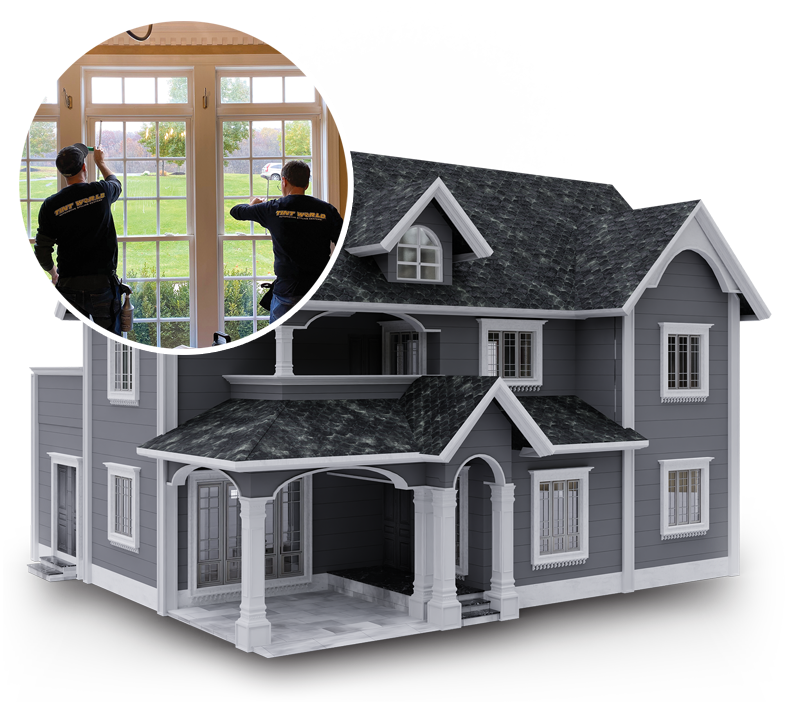Residential Window Tint: Protect Your Furniture from UV Damages
Residential Window Tint: Protect Your Furniture from UV Damages
Blog Article
Exactly How Residential Home Window Tinting Improves Your Home's Power Efficiency
Residential window tinting presents a compelling service for homeowners looking for to boost energy efficiency within their living areas. By applying specialized movies to home windows, it efficiently reduces warm transfer, therefore stabilizing indoor temperatures and reducing the demand for too much home heating or cooling.
Understanding Home Window Tinting
Comprehending home window tinting is essential for home owners looking for to improve both convenience and energy performance in their space. Residential Window Tint. Window tinting entails the application of a slim movie to the interior or exterior surface of glass home windows. This movie can considerably modulate the quantity of sunlight and heat that goes into a home, therefore affecting interior environment conditions
There are various kinds of window tinting movies readily available, each with unique residential properties. Dyed movies take in solar power, while reflective films deflect it away from the glass surface. Ceramic films offer an equilibrium of visibility and warm denial, making them a prominent selection among house owners. The effectiveness of home window tinting is usually gauged by its Visible Light Transmission (VLT) percentage, which suggests exactly how much light can travel through the movie.
Benefits of Energy Efficiency
Home window tinting not just improves aesthetic appeals but additionally plays a significant role in boosting energy effectiveness within residential rooms. By reducing warm transfer with windows, tinted films produce a more steady interior climate, which can cause substantial decreases in power usage for cooling and heating. This power efficiency converts into lower energy expenses, offering homeowners with substantial long-term savings.

In addition, home window tinting enhances the comfort of living areas. By minimizing glow and blocking dangerous UV rays, colored home windows create an even more pleasurable setting, which can result in enhanced well-being for residents. The security versus UV rays likewise aids preserve furnishings and floor covering from fading, adding to the long life of family things.
Exactly How Tinting Functions
Tinting movies operate through a mix of innovative materials and modern technologies created to regulate the quantity of solar power entering a home. Primarily composed of polyester, these films commonly integrate ceramic or metallic particles that show and soak up heat. This twin capability enables them to considerably lower the penetration of ultraviolet (UV) rays and infrared radiation while allowing noticeable light to go through.
The performance of window tinting is determined by its solar heat gain coefficient (SHGC), which indicates just how much solar power is sent via the home window. Lower SHGC worths are preferable as they represent better warmth rejection. Furthermore, home window tints can include a range of tones, allowing property owners to tailor their visual preferences while enhancing power efficiency.
Additionally, these movies work as an obstacle, preventing heat loss during chillier months by showing indoor heat back right into the space. This thermal insulation effect complements the cooling benefits acquired during warmer months, contributing to a balanced indoor environment year-round. By managing solar energy effectively, domestic window tinting not only improves comfort but likewise plays an important function in decreasing energy consumption and lowering utility bills.
Picking the Right Color

There are different kinds of window films offered, consisting of colored, metalized, and ceramic. Ceramic films offer superb heat control without compromising exposure and are extremely sturdy, making them a popular choice.
Visible light transmission (VLT) is one more critical factor, as this page it indicates the amount of all-natural light that can travel through the colored glass. Home owners should select a tint with a VLT that matches their illumination choices while still offering ample glare decrease.
In addition, evaluating the solar warmth gain coefficient (SHGC) can assist establish how well a tint can block warmth from sunshine. A reduced SHGC suggests much better heat control, ultimately enhancing energy performance.
Setup and Maintenance Tips
Correct setup and maintenance are crucial components in optimizing the benefits of residential home window tinting. To achieve optimum results, it is suggested to employ a qualified specialist for installation. This makes certain that the color is applied properly, avoiding air bubbles, creases, or misalignment that can compromise efficiency. Experts additionally utilize specialized devices and methods, which can boost the sturdiness and effectiveness of the color.
Complying with installment, maintenance is essential to extend the life of the home window film. It is suggested to wait at the very least 1 month before cleansing the tinted home windows to allow the sticky to heal Visit This Link fully. When cleaning, utilize a soft towel and a gentle, ammonia-free cleaner to stay clear of damaging the movie. Avoid rough products that could scratch the surface.
Attending to these problems promptly can prevent more damages and preserve energy performance. By sticking to these installation and upkeep pointers, house owners can ensure their window tinting proceeds to supply significant power financial savings and comfort for years to come.
Conclusion
In final thought, property window tinting serves as an efficient remedy for click site improving power effectiveness within homes. By minimizing warm transfer and obstructing harmful UV rays, window films contribute to reduce power usage and boosted indoor comfort.
Home window tinting involves the application of a thin film to the inside or outside surface of glass windows. By minimizing warmth transfer through windows, tinted films create a much more secure interior climate, which can lead to significant reductions in power intake for home heating and air conditioning.The effectiveness of window tinting is determined by its solar warm gain coefficient (SHGC), which shows just how much solar power is transmitted through the window. By handling solar energy successfully, household home window tinting not only enhances comfort however likewise plays an essential duty in reducing energy consumption and lowering utility expenses.
By minimizing warmth transfer and obstructing hazardous UV rays, window films contribute to lower power consumption and enhanced indoor comfort.
Report this page